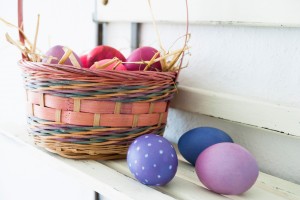It is nearly impossible to think about Easter without conjuring images of brightly dyed eggs. They are as synonymous with the holiday as the Easter Bunny himself. There are a number of different theories, all fascinating, about how dyeing eggs became such an integral practice for the Easter holiday.
Many cultures view eggs as symbols of rebirth and new life, making them an appropriate item to use in celebrations of spring, including pagan festivals. Interestingly, both the pagans and Christians adopted the practice of decorating eggs and giving them as gifts.
Christians considered eggs to be the perfect representation of the resurrection of Jesus Christ. Some surmise that this practice is rooted in ancient Mesopotamia, where Christians dyed eggs red to mimic the blood that Jesus Christ shed during his crucifixion. In fact, in one Catholic legend, a basket of eggs that Mary Magdalene carried to share with the other women who traveled to Jesus Christ’s tomb to mourn his death turned a vibrant shade of red when Mary Magdalene discovered the tomb was empty.
King Edward I of England got in on the act when he ordered 450 eggs to be colored and decorated with gold-leaf. He then presented the pretty eggs as Easter gifts to the other members of the royal household. This story brings to mind the modern interpretation of the practice, which often includes spirited Easter egg hunts in hot pursuit of the colored eggs.
When it comes to dyeing Easter eggs, you likely know the drill. Buy the kit from a store, set up shop and try not to breathe too deeply in the midst of the overpowering odor that the dye mixture releases. But it does not have to be this way. Options exist for making dye from natural products you may even already have in your kitchen cabinets. Think about those early Christians and King Edward I of England’s staff; neither had access to processed dye.
Going Au Naturel
Bear in mind that this approach comes with some unpredictability. Different characteristics of the eggs will determine how the dye is absorbed and how the colors will display. Certain leaves, berries or spices may cause a chain reaction with a particular egg. And the texture of the eggs can affect how the color is absorbed. Even the freshness of the eggs can change the outcome. This lack of routine puts a fun spin on the traditional practice.
Two primary methods exist for dyeing eggs the natural way. In the first, often dubbed the “cold method,” both the eggs and dye are kept at room temperature or colder throughout the process. Allow the dye to cool down before submerging the eggs into the liquid. Let them sit in the dye for at least 30 minutes – or longer if you desire a deeper hue. However, make sure you store the eggs and dye mix in the refrigerator if you opt to steep them overnight.
The second method involves simmering the main ingredient of the dye and the eggs simultaneously, thereby cooking and dyeing the eggs in one sitting. This tactic produces darker shades. In general, submerging the eggs in the dye for a longer period of time will produce deeper colors, although as mentioned previously, the eggs can defy this logic when dyeing them naturally. One drawback of the “hot method” is that it also produces eggs that could end up too tough to eat, as a result of the lengthy cooking time.
Creating the Dye
Make sure you have plenty of the main dye ingredient on hand. Natural food dyes require a large quantity of produce to significantly alter the coloring. For example, when producing a blue or green dye from purple cabbage, you will need a complete head of cabbage. If lavender or red eggs are on your itinerary, you will need an entire bag of red onion skins. And be prepared to use at least four cups of dye liquid for every dozen eggs.
When it comes to natural items to use for dye, the possibilities are nearly endless. The long list of main ingredients includes the aforementioned purple cabbage and red onion skins, blueberries, raspberries, beets, turmeric, curry, coffee and tea. Use this helpful color guide when shopping for items:
- Purple dye – hibiscus tea leaves or cranberry juice
- Pink or red dye – fresh beets, pickled beet juice, cranberries, frozen raspberries, red wine or red onion skins
- Orange dye – paprika or chili powder
- Yellow dye – ground turmeric, curry powder or ground cumin
- Tan dye – yellow onion skins or green tea
- Gray dye – blackberries
- Brown dye – coffee or black tea
The following recipe makes four to six cups of dye:
- Minimum of four cups chopped fruits or vegetables / two to three tablespoons spices
- Four to six cups water
- Two tablespoons white vinegar for every four to six cups of water
Combine spices or produce, water and vinegar. Bring to a boil and then simmer for 15 to 30 minutes. Choose either the “cold method” or “hot method” to dye the eggs.
As you can see, coloring Easter eggs with dye made from natural items is not complicated. You could even turn the creation of the dye into a family event; recruit your children or other family members to help you shop, chop and prepare it.
You and your family will feel like artists in the making as you wait to see exactly how the colors for each egg will display. In this sense, each egg is truly unique, and participants will enjoy taking ownership of “their” eggs.
Relive a little piece of history, long before the advent of Egg dyeing kits. It will make the tradition feel extra special and festive.
Follow Arbor Mills’s board All Natural Easter Eggs on Pinterest.






